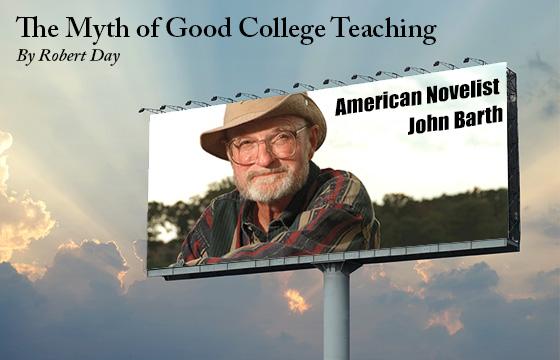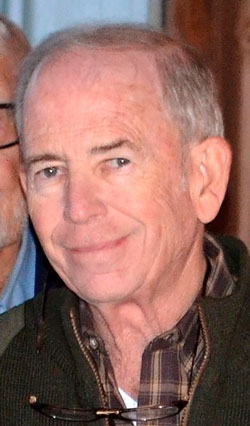This introduction in 2011 by the late Robert Day, writer and professor at Washington College, of his friend and fellow author John Barth has special meaning as the Spy notes his passing on Tuesday of one of Cambridge’s truly great native sons and America’s literary treasures.
Our guest tonight has 1,810,000 references on Professor Google’s list of suggested readings. Surely not all refer to our John Barth (the real John Barth), but among that daunting number, there are the following: a long John Barth Wikipedia entry, The (real) John Barth Information Center, a Who Is (our) John Barth? site, a Scriptorium, various teaching guides, blogs, reviews, general articles of praise, and, finally, there is a site titled The Images of John Barth, a site that has quite a portfolio of photographs, but not — I am somewhat pleased to say — the one that is on the poster you have seen around town. Thus, with a push of one or two keys on whatever Pad you use, you can browse an immense literary library of one of America’s most accomplished authors. With that I cannot compete: my name is Robert Day and I have known Jack for nearly forty years: mine will be a personal introduction.
We met when Jack and I tried to convince one another that I should be the Director of the Johns Hopkins Graduate Creative Writing Program. I was then teaching at Washington College, here in Chestertown, where it turned out I stayed. But from those first days when I toured the Hopkins Writing Seminars, meeting the faculty and students, Jack and I became friends because of — as Montaigne writes — who he is and who I am.
Not long after our pas de deux at Hopkins, Jack called to say he would be coming to Chestertown (where he and Shelly had recently bought a house) the following Friday and would I join him for lunch? Agreed. It was to be the beginning of scores of Friday lunches, continuing to this day. We met that first time I do not remember where, but I do remember two things about it: that the nature of our talk was rangy, ebullient, and almost exclusively literary. Well, not exclusively literary, because from the first we’d swap jokes — Jack beginning with a series of Hillbilly pig jokes when he learned I had studied a stint at the University of Arkansas. The second thing I remember is that someone must have spotted Jack (a new book of his was just out with his photograph appearing in the papers), and took our picture.
Those of you who are avid readers of John Barth will know that those Friday lunches Jack and I shared were because of, or resulted in, or some formulation thereof, his two collections of essays. The Friday Book and Further Fridays — the latter collection including his famous essay “Browsing,” first delivered as a lecture here at Washington College and first published by the Literary House Press of Washington College.
And so our literary lunch Fridays commenced and continued. Not every Friday, but many over the years until Jack stopped teaching at Hopkins and thus was more often in Chestertown — in which case our Fridays turned themselves into Wednesdays or Mondays — or encore, a real Friday itself.
In the beginning, one of us would pay the lunch tab, then the next time the other way round, even though sometimes we’d get confused. At one lunch I said I thought it was my turn but Jack said no, it was his, and he insisted; and I said, I’m not sure we’re even, to which Jack said: friends are never even. About that time, once again, someone took our picture.
“What do you think the caption will be?” I had asked Jack. “You first,” he said. “Nationally famous author lunching with unidentified man,” I said. “I’ll pass,” he said, but in the moment of silence between us, I thought that his fertile and fervent literary imagination could have made an entire novel out of my minimalist caption. And maybe yet it shall.
What our John Barth has accomplished with his imagination is the creation of a world of fiction unlike any other American writer. And the landscape of that fictive world is immense: from the early realistic and nihilistic novels, The Floating Opera and The End of the Road, to the faux historical novels, The Sot-Weed Factor and Giles Goat Boy, and then changing course to On With the Story, Letters, The Tidewater Tales, and back again to Coming Soon and The Development. And I see I have left out Lost in the Fun House, The Last Voyage of Somebody the Sailor, On with the Story, among others — and among those others, is his most recent book: Every Third Thought, A Novel in Five Seasons from which he will read this evening.
And that long list of publications is nearly matched by a long list of awards, starting with two nominations for the National Book Award, and in 1973, the National Book Award for Chimera. These were followed by a National Institute of Arts and Letters grant in literature, The Brandeis University Creative Arts Award in fiction, a Rockefeller Foundation grant in fiction. And those in turn have been followed by an election to the American Academy of Arts and Letters as well as to the American Academy of Arts and Sciences, the Scott Fitzgerald Award for Outstanding Achievement in American Fiction, the Lannan Foundation Lifetime Achievement Award, a PEN/Malamud Award for “Excellence in the Short Story,” and the Enoch Pratt Society’s Lifetime Achievement in Letters Award. However, those of us associated with Washington College are surely most proud that he joins Toni Morrison, Richard Wilbur, Galway Kinnell, Mavis Gallant, Israel Horovitz and William Warner (our William Warner) as a holder of our own Washington College Literary Award.
Jack’s writing is not so much a landscape of fiction as an Ocean of Story. But writers are not unique just because of the breadth or size of their oeuvre. There has to be something else. A Washington Post Magazine editor that we shared called that “something else” in Jack’s writing “The Pyrotechnics of Prose.” And he was right.
It is as if his muse is a character in his fiction, at least the muse that is his gift of language. Surely some critic somewhere has noticed the jazz improvisations in Jack’s writing: I have. They are what we who write call invention. It comes from where we’ve been coming from in the paragraphs before, and the chapters before that. And it comes from where we’ve come from as readers: in Jack’s case, back to Lawrence Stern in English and further back than that in ancient languages and oft-told old tales told on a thousand and one nights. All of these our John Barth spins into tales of his own, with his own voice and muse doing the spinning. Like Joyce and Nabokov and Garcia Marquez and Italio Calvino, Jack conjures a maelstrom into an Ocean of Story. He is Tradition and Individual Talent. And fireworks at sea.
The poster: the one that has been around town advertising Jack’s reading this evening. It is not the case that our photograph (yes, those two young-looking guys are the two of us up here) was taken in a café while we were having lunch. It was taken on the steps of Richmond House, the first Literary House at Washington College, and it was taken on the occasion of Jack’s visit in the late 1970’s to Washington College, where he met with students and faculty. However, it wasn’t all that long ago that, once again at lunch, we got shot. By now 30 years had gone by. I had taught thousands of students here at Washington College, and those students were now sending their children, and toward the end of my teaching at the college, their grandchildren to Washington College. Mothers and fathers and a few grandmothers and grandfathers were now coming back for Parents’ Weekends and Graduations. And having lunch out. Some stopping me to reintroduce themselves.
“What’s the caption?” I asked Jack after the most recent shot was shot.
“Locally-famous professor having lunch with unidentified man,” he said. To which in the small silence between us I thought: lucky me to have had a long line of Friday lunches with my friend talking books and telling jokes. And to which I now add: lucky all of us who are avid readers of muse-inspired American literature to have John Barth, the real John Barth, our John Barth, with his firecracker prose going off like St. Elmo’s fire in his Oceans of stories. Lucky indeed.
Ladies and Gentlemen, my uneven friend, John Barth.
Robert Day is Professor of English, Emeritus at Washington College, and author of “The Last Cattle Drive” as well as numerous articles in magazines and academic journals.






